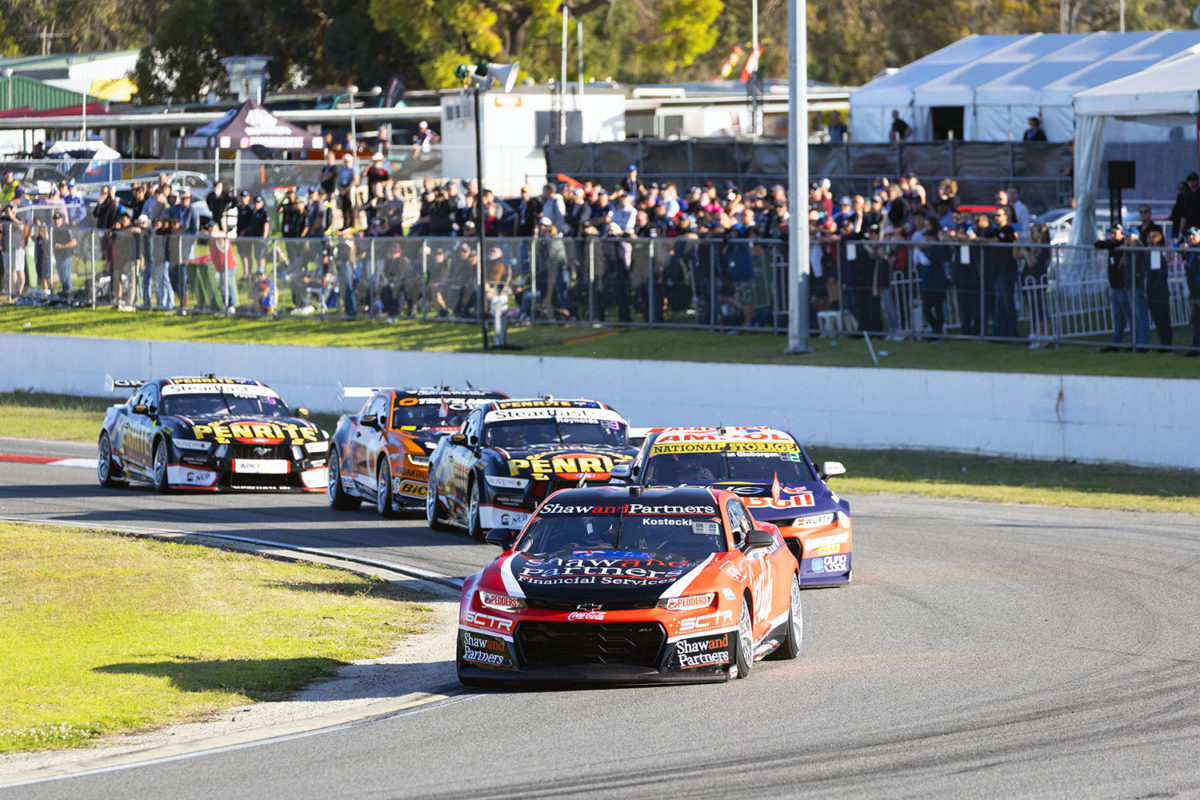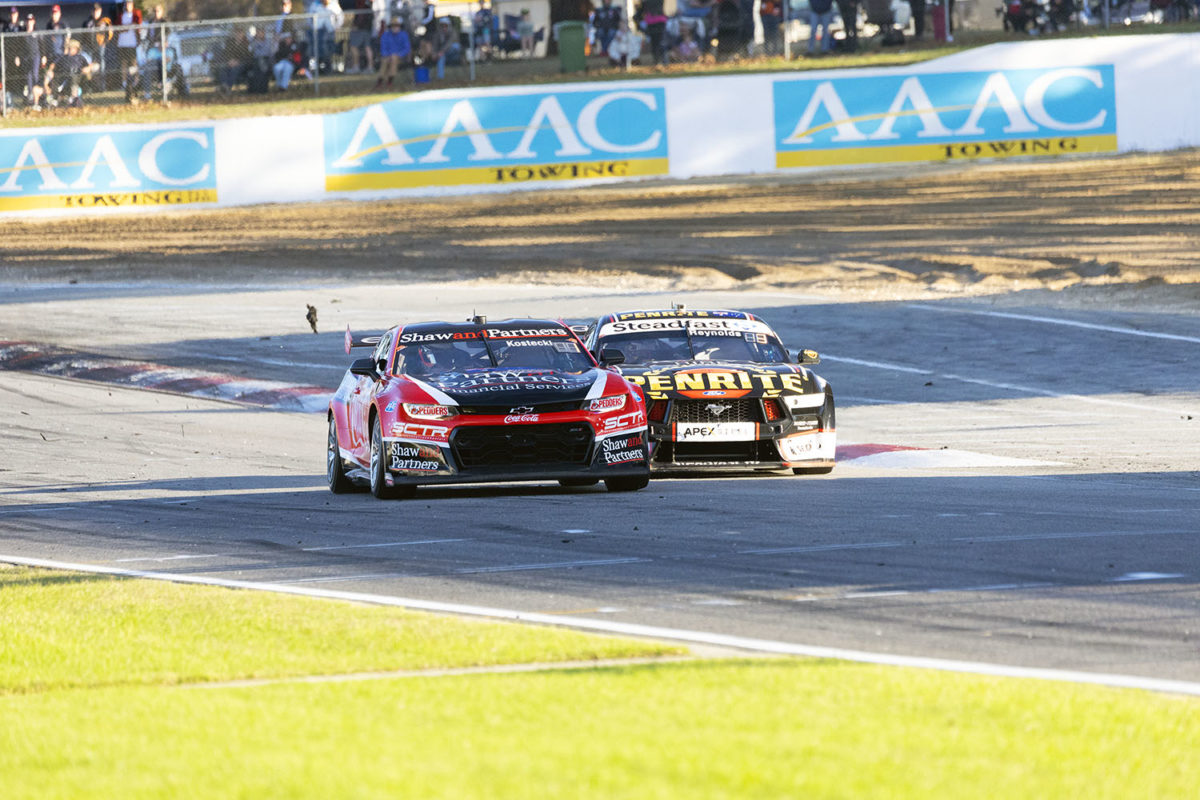

The revelation that Supercars is investigating use of a local transient dynamometer points to the big unanswered question in the engine parity debate which is currently raging.
So far, the 2023 Repco Supercars Championship has been dominated by Chevrolet Camaro drivers, who have collectively been first to the chequered flag in all nine races.
It is a formline which led Tickford Racing driver Cameron Waters to quip at the end of the most recent event of the season, at Perth’s Wanneroo Raceway, that he was racing his Ford Mustang in “Class B”.
Now, a new theory as to why a disparity might exist has emerged, namely engine inertia.
Such is the nature of Gen3, the Camaro and Mustang are near enough to identical, regardless of team.
Identical, that is, except for under the bonnet, given their respective engines are of different displacement and architecture.
The Chevrolet’s is a 5.7-litre unit of pushrod design, whereas the Ford’s is a 5.4-litre unit of double overhead cam (or ‘quad cam’) configuration.
The size of a cylinder is defined by its bore, that being its diameter, and its stroke, that being the distance travelled by the piston from top to bottom in each cycle.
All other things being equal (including the number of cylinders; in this case, eight), the stroke of a larger capacity engine must therefore be longer than that of a smaller capacity engine.
Ironically, that is understood to not be the case with respect to the Supercars engines.
Multiple sources have told Speedcafe that the Coyote-derived Ford engine features a relatively narrow bore – the physical properties of the production version mean this is highly likely – and hence must have a considerably longer stroke than that of the Chevrolet.
Furthermore, the Ford engine is somewhat undersquare, which is unusual for a race engine, while the Chevrolet engine is considerably oversquare.
In engine parlance, ‘square’ refers to the condition whereby bore is (approximately) equal to stroke, whereas an oversquare engine has a bore wider than the stroke is long, and an undersquare engine has a bore narrower than the stroke is long.
Given the Ford engine’s stroke is said to be around 10mm longer than that of the Chevrolet engine, achieved through a bigger crank throw, the theory is that it must have a heavier counterweight, and thus would have more inertia.
That theory is consistent with suggestions from within the paddock that the Ford engine does not accelerate as quickly as the Chevrolet engine does, particularly in fourth, fifth, and sixth gears.
It is also consistent with suggestions that Ford drivers are using their rear tyres harder and therefore struggling in race conditions, because the initial lack of acceleration entices them to give more throttle input which over-stresses the rubber once the torque does arrive.
Indeed, while a two from nine pole position conversion rate is barely better than a one from nine race win rate (noting also that the sole win arose because of a Triple Eight Race Engineering disqualification), Mustang drivers have been far more competitive in qualifying and practice than in races.
In Qualifying for Race 8 at Wanneroo, for example, Grove Racing’s David Reynolds set a time in his Mustang which was only 0.0404s slower than the pole effort from Erebus Motorsport’s Will Brown.
There are, of course, other differences which could explain a (possible) disparity in power delivery, including the inherent complexity of the Ford engine.
There is the question of what the extra camshafts and valve spring movements mean for inertia, although one theory is that the extra weight in quantity should be all but cancelled out by the likelihood that the individual components would be lighter in a quad cam engine than in a pushrod unit.
The crankshaft in the Ford engine, however, is most likely heavier.
Moment of inertia was publicly identified by Supercars itself as one of the five key considerations with respect to engine parity, in the Gen3 Unpacked video series of 2021, the others being power/torque, fuel consumption, weight, and centre of gravity.
Weight and centre of gravity would seem to have been resolved, while fuel consumption remains a question mark.
On power/torque, Supercars uses two metrics to determine parity, namely AEP (‘Accumulated Engine Power’) and EPWA (‘Engine Power Weighted Average’).
In Episode 5 of Gen3 Unpacked, Supercars engine expert Craig Hasted described AEP as follows:
“This is where we test the engine on a dynamometer; we measure the power from 5800 to 7450, at 50 RPM increments.
“The total addition of that power is the maximum power that any engine can make.
“It’s the same process we run with the current engines. It’s been very, very successful.”
He described EPWA as follows:
“What that does, that ensures that the curve is in a similar position.
“That way, it stops someone from making a whole heap of power at 6000 and less at 7500, and vice versa, at different tracks.”
Supercars Head of Motorsport Adrian Burgess subsequently advised, in December 2022, that the category had broadened the range over which it captures AEP because the Gen3 engines have “a lot more power low down.”
However, that would not account for the inherent differences in the 5.4-litre Ford quad cam and the 5.7-litre Chevrolet pushrod.
It may very well be the case that those engines have near enough to identical AEP and EPWA figures.
However, that is not to say that each engine necessarily reaches a particular RPM figure at the same time.
Furthermore, while the preoccupation thus far has apparently been about going faster – acceleration – inertia is not a one-way concept.
Slower acceleration corresponds to slower deceleration, which makes braking more difficult, and hence would elongate braking zones.
It should be stressed, though, that all of the above is merely theory at this point in time.
Speaking more broadly on engine parity during the Wanneroo event, Tickford Team Principal Tim Edwards highlighted to Speedcafe the importance of data if one is to make an informed assessment of the state of play.
Ford competitors, of course, think they are at a disadvantage, but Chevrolet competitors could – and, indeed, have – just as legitimately argue that the current debate is largely driven by conjecture, rather than facts.

Supercars, as noted above, was aware of the importance of moment of inertia, and both engines were run on transient dynamometers in the United States last year.
Whether that testing was sufficiently rigorous is also up for debate but, if Supercars knew about the potential inertia disparity, then there would have been some effort to account for it.
Then, it is said, the prototype Camaro and Mustang were set up with the same springs, same shocks, same camber, and same rake.
The purpose of the speed testing was to assess acceleration, and homologation of the two race cars was announced as formal in the following week, although Engine Specification Documents are understood to still not be locked down.
A longer shift cut remains in the Camaro’s powertrain as an interim parity measure, but the nature and cause of what Burgess referred to as the Mustang’s “anomaly post-shift” is also debated.
Chevrolet competitors might also be inclined to reason that the results so far are not as lopsided as they appear.
Only two of the six Chevrolet teams have won races – Erebus and Triple Eight – and it has been put to Speedcafe that the Mustang cannot be that uncompetitive if Todd Hazelwood set the fastest lap in Race 7 at Wanneroo in the Blanchard Racing Team Ford.
Then in Race 9, for example, the most recent of the season, the podium was Triple Eight-Erebus-Erebus, but the next four positions featured all four Ford teams other than BRT (Grove, Walkinshaw Andretti United, Tickford, and Dick Johnson Racing).
Could it just be that Erebus and Triple Eight are doing a better job than their rivals, both within the Chevrolet camp and also on the Ford side of the divide?
For now, the parity debate continues.




















Discussion about this post